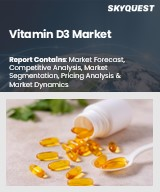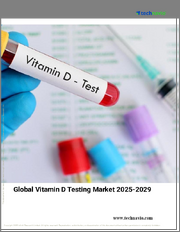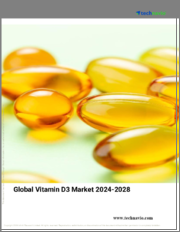
|
시장보고서
상품코드
1488216
비타민 D 제조 플랜트 프로젝트 보고서(2024년) : 산업 동향, 플랜트 설립, 기계, 원재료, 투자 기회, 비용, 수익Vitamin D Manufacturing Plant Project Report 2024: Industry Trends, Plant Setup, Machinery, Raw Materials, Investment Opportunities, Cost and Revenue |
||||||
IMARC Group이 발행한 "비타민 D 제조 플랜트 프로젝트 보고서(2024년) : 산업 동향, 플랜트 설립, 기계, 원재료, 투자 기회, 비용, 수익" 보고서는 비타민 D 제조 플랜트 설립을 위한 완벽한 로드맵을 제공합니다. 종합적인 시장 개요부터 관련 단위 작업, 원자재 요구 사항, 유틸리티 요구 사항, 인프라 요구 사항, 기계 및 기술 요구 사항, 인력 요구 사항, 포장 요구 사항, 운송 요구 사항과 같은 미시적 수준의 정보까지 포괄적으로 다루고 있습니다. 이 보고서는 설비 투자, 프로젝트 자금, 운영비, 손익 예측, 고정비 대 변동비, 직접비 대 간접비, 예상 ROI 및 순현재가치(NPV), 손익 계산, 재무 분석 등 비타민 D 제조 플랜트 비용에 영향을 미치는 프로젝트 경제성에 대한 자세한 인사이트를 제공합니다.
본 보고서에서 다루는 주요 질문
- 비타민 D 시장은 지금까지 어떻게 성장해왔고, 앞으로 어떻게 성장할 것인가?
- 세계 비타민 D 시장의 시장 세분화는?
- 비타민 D 세계 시장 지역별 분류는?
- 비타민 D 산업에서 각종 원료의 가격 동향은?
- 비타민 D 산업의 구조와 주요 플레이어는?
- 비타민 D 제조 플랜트의 다양한 단위 작업은 무엇인가?
- 비타민 D 제조 플랜트 설립에 필요한 총 면적은?
- 비타민 D 제조 플랜트의 레이아웃은?
- 비타민 D 제조 플랜트 설립에 필요한 기계는?
- 비타민 D 제조 플랜트 설립에 필요한 원료는?
- 비타민 D 제조 플랜트 설립에 필요한 포장이란?
- 비타민 D 제조 플랜트 설립에 필요한 운송수단은?
- 비타민 D 제조 플랜트 설립에 필요한 유틸리티는?
- 비타민 D 제조 플랜트 설립에 필요한 인적 자원은?
- 비타민 D 제조 플랜트 설립에 필요한 인프라 비용은?
- 비타민 D 제조 플랜트의 자본 비용은 얼마인가요?
- 비타민 D 제조 플랜트의 운영 비용은?
- 최종 제품의 가격 메커니즘은 어떻게 해야 하는가?
- 비타민 D 제조 플랜트의 손익은?
- 손익분기점에 도달하는 데 필요한 시간은?
- 비타민 D 제조 플랜트 설립에 따른 수익 예측은?
- 비타민 D 산업의 주요 성공요인과 위험 요인은 무엇인가?
- 비타민 D 제조 플랜트 설립에 필요한 주요 규제는?
- 비타민 D 제조 플랜트 설립에 필요한 주요 인증은?
목차
제1장 서문
제2장 조사 범위와 조사 방법
- 조사 목적
- 이해관계자
- 조사 방법
제3장 주요 요약
- 시장 시나리오
- 원재료 수요
- 수입 예측
- 지출 예측
- 이익 분석
제4장 비타민 D 세계 시장
- 시장 개요
- 과거와 현재의 시장 실적
- COVID-19의 영향
- 부문별 시장 내역
- 지역별 시장 내역
- 가격 동향
- 시장 예측
- 경쟁 상황
제5장 상세한 프로세스 플로우
- 제품 개요
- 다양한 단위 조작
- 품질 보증 기준
- 기술 시험
- 매스 밸런스와 원재료 요건
제6장 프로젝트 상세, 요건 및 관련 비용
- 토지, 입지, 부지 개발
- 플랜트 레이아웃
- 플랜트 기계
- 원재료
- 포장
- 수송
- 유틸리티
- 인재 요건과 임금
제7장 융자와 자금 원조
제8장 프로젝트 경제학
- 프로젝트 자본 비용
- 기술 경제 파라미터
- 수입 예측
- 지출 예측
- 제품 가격과 마진
- 과세
- 감가상각
- 재무 분석
제9장 규제 절차와 승인
제10장 인증 요건
제11장 주요 성공요인과 위험요인
제12장 전략적 제안
제13장 성공한 벤처기업 사례 연구
ksm 24.06.11IMARC Group's report, titled "Vitamin D Manufacturing Plant Project Report 2024: Industry Trends, Plant Setup, Machinery, Raw Materials, Investment Opportunities, Cost and Revenue" provides a complete roadmap for setting up a vitamin D manufacturing plant. It covers a comprehensive market overview to micro-level information such as unit operations involved, raw material requirements, utility requirements, infrastructure requirements, machinery and technology requirements, manpower requirements, packaging requirements, transportation requirements, etc. The report provides detailed insights into project economics influencing the vitamin D manufacturing plant cost, including capital investments, project funding, operating expenses, income and expenditure projections, fixed costs vs. variable costs, direct and indirect costs, expected ROI and net present value (NPV), profit and loss account, financial analysis, etc.
Vitamin D is a crucial fat-soluble nutrient that plays a fundamental role in maintaining overall health and well-being. Often referred to as the "sunshine vitamin," Vitamin D is unique, as the human body can produce it when exposed to sunlight. It also exists in dietary sources such as fatty fish, fortified dairy products, and certain mushrooms. Vitamin D is essential for various physiological functions, including calcium absorption and bone health. It helps regulate the immune system, supports cardiovascular health, and influences cell growth and differentiation. In recent years, research has highlighted the importance of Vitamin D in reducing the risk of chronic diseases and improving overall immune function.
Vitamin D offers numerous benefits and applications for overall health. Primarily known for its role in maintaining strong bones by aiding calcium absorption, Vitamin D also supports immune system function, cardiovascular health, and cell growth. Adequate Vitamin D levels are crucial for reducing the risk of osteoporosis, supporting muscle strength, and preventing chronic diseases. The main application of Vitamin D is in the prevention and treatment of Vitamin D deficiencies. Besides sunlight exposure, dietary sources like fatty fish, fortified dairy, and supplements are essential for maintaining sufficient Vitamin D levels, particularly for individuals with limited sun exposure or specific health conditions.
The market for Vitamin D has experienced significant growth, driven by several key market drivers and emerging trends. One of the primary drivers is the increasing awareness of the importance of Vitamin D in maintaining overall health. As consumers become more health-conscious, there is a growing emphasis on preventive health measures, including Vitamin D supplementation, to support bone health, immune function, and reduce the risk of chronic diseases. Furthermore, the rising prevalence of Vitamin D deficiencies has contributed to the market growth. Factors such as limited sun exposure, cultural practices, and dietary preferences have led to a significant portion of the population having insufficient Vitamin D levels. As a result, there is a higher demand for Vitamin D supplements and fortified foods to address these deficiencies. The COVID-19 pandemic has also impacted the market for Vitamin D. Studies have suggested that sufficient Vitamin D levels may help reduce the severity of respiratory infections, including COVID-19. As a result, there has been increased consumer interest in Vitamin D supplements as a potential preventive measure against viral infections. Another significant market driver is the aging population. Older adults are more susceptible to Vitamin D deficiencies and related health issues, such as osteoporosis and weakened immune function. Consequently, there is a growing demand for Vitamin D supplements to support healthy aging and maintain optimal health in this demographic. In terms of trends, there has been a shift towards natural and plant-based sources of Vitamin D. Consumers are seeking Vitamin D supplements derived from algae or lichens, suitable for vegetarians and vegans. Additionally, the demand for clean-label products has led to a preference for Vitamin D supplements without artificial additives or preservatives. The fortification of foods with Vitamin D is also a notable trend, as food manufacturers and governments are increasingly incorporating Vitamin D into products like dairy, cereals, and plant-based milk to enhance nutritional content and promote public health.
The following aspects have been covered in the report on setting up a vitamin D manufacturing plant:
Market Analysis:
Market Trends
Market Breakup by Segment
Market Breakup by Region
Price Analysis
Impact of COVID-19
Market Forecast
The report provides insights into the landscape of the vitamin D industry at the global level. The report also provides a segment-wise and region-wise breakup of the global vitamin D industry. Additionally, it also provides the price analysis of feedstocks used in the manufacturing of pasta sauce, along with the industry profit margins.
Detailed Vitamin D Manufacturing Process Flow:
Product Overview
Unit Operations Involved
Mass Balance and Raw Material Requirements
Quality Assurance Criteria
Technical Tests
The report also provides detailed information related to the vitamin D manufacturing process flow and various unit operations involved in a manufacturing plant. Furthermore, information related to mass balance and raw material requirements has also been provided in the report with a list of necessary quality assurance criteria and technical tests.
Project Details, Requirements and Costs Involved:
Land, Location and Site Development
Plant Layout
Machinery Requirements and Costs
Raw Material Requirements and Costs
Packaging Requirements and Costs
Transportation Requirements and Costs
Utility Requirements and Costs
Human Resource Requirements and Costs
The report provides a detailed location analysis covering insights into the land location, selection criteria, location significance, environmental impact, and expenditure for vitamin D manufacturing plant setup. Additionally, the report provides information related to plant layout and factors influencing the same. Furthermore, other requirements and expenditures related to machinery, raw materials, packaging, transportation, utilities, and human resources have also been covered in the report.
Project Economics:
Capital Investments
Operating Costs
Expenditure Projections
Revenue Projections
Taxation and Depreciation
Profit Projections
Financial Analysis
The report also covers a detailed analysis of the project economics for setting up a vitamin D manufacturing plant. This includes the analysis and detailed understanding of capital expenditure (CapEx), operating expenditure (OpEx), income projections, taxation, depreciation, liquidity analysis, profitability analysis, payback period, NPV, uncertainty analysis, and sensitivity analysis. Furthermore, the vitamin D manufacturing plant report also provides a detailed analysis of the regulatory procedures and approvals, information related to financial assistance, along with a comprehensive list of certifications required for setting up a vitamin D manufacturing plant.
Key Questions Answered in This Report:
- How has the vitamin D market performed so far and how will it perform in the coming years?
- What is the market segmentation of the global vitamin D market?
- What is the regional breakup of the global vitamin D market?
- What are the price trends of various feedstocks in the vitamin D industry?
- What is the structure of the vitamin D industry and who are the key players?
- What are the various unit operations involved in a vitamin D manufacturing plant?
- What is the total size of land required for setting up a vitamin D manufacturing plant?
- What is the layout of a vitamin D manufacturing plant?
- What are the machinery requirements for setting up a vitamin D manufacturing plant?
- What are the raw material requirements for setting up a vitamin D manufacturing plant?
- What are the packaging requirements for setting up a vitamin D manufacturing plant?
- What are the transportation requirements for setting up a vitamin D manufacturing plant?
- What are the utility requirements for setting up a vitamin D manufacturing plant?
- What are the human resource requirements for setting up a vitamin D manufacturing plant?
- What are the infrastructure costs for setting up a vitamin D manufacturing plant?
- What are the capital costs for setting up a vitamin D manufacturing plant?
- What are the operating costs for setting up a vitamin D manufacturing plant?
- What should be the pricing mechanism of the final product?
- What will be the income and expenditures for a vitamin D manufacturing plant?
- What is the time required to break even?
- What are the profit projections for setting up a vitamin D manufacturing plant?
- What are the key success and risk factors in the vitamin D industry?
- What are the key regulatory procedures and requirements for setting up a vitamin D manufacturing plant?
- What are the key certifications required for setting up a vitamin D manufacturing plant?
Table of Contents
1 Preface
2 Scope and Methodology
- 2.1 Study Objectives
- 2.2 Stakeholders
- 2.3 Research Methodology
3 Executive Summary
- 3.1 Market Scenario
- 3.2 Raw Material Requirements
- 3.3 Income Projections
- 3.4 Expenditure Projections
- 3.5 Profit Analysis
4 Global Vitamin D Market
- 4.1 Market Overview
- 4.2 Historical and Current Market Performance
- 4.3 Impact of COVID-19
- 4.4 Market Breakup by Segment
- 4.5 Market Breakup by Region
- 4.6 Price Trends
- 4.6.1 Raw Material Price Trends
- 4.6.2 Vitamin D Price Trends
- 4.6.3 Product Margins
- 4.7 Market Forecast
- 4.8 Competitive Landscape
- 4.8.1 Market Structure
- 4.8.2 Key Players
- 4.8.3 Profiles of Key Players
5 Detailed Process Flow
- 5.1 Product Overview
- 5.2 Various Types of Unit Operations Involved
- 5.3 Quality Assurance Criteria
- 5.4 Technical Tests
- 5.5 Mass Balance and Raw Material Requirements
6 Project Details, Requirements and Costs Involved
- 6.1 Land, Location and Site Development
- 6.1.1 Overview of Land Location
- 6.1.2 Selection Criteria and Significance
- 6.1.3 Location Analysis
- 6.1.4 Project Planning and Phasing of Development
- 6.1.5 Environmental Impact
- 6.1.6 Land Requirement and Costs
- 6.2 Plant Layout
- 6.2.1 Overview
- 6.2.2 Importance and Essentials
- 6.2.3 Layout
- 6.2.4 Factors Influencing Layout
- 6.3 Plant Machinery
- 6.3.1 Machinery Requirements
- 6.3.2 Machinery Costs
- 6.3.3 Machinery Suppliers (Provided on Request)
- 6.3.4 Machinery Pictures
- 6.4 Raw Materials
- 6.4.1 Raw Material Requirements
- 6.4.2 Raw Material Details and Procurement
- 6.4.3 Raw Material Costs
- 6.4.4 Raw Material Suppliers (Provided on Request)
- 6.4.5 Raw Material and Final Product Pictures
- 6.5 Packaging
- 6.5.1 Packaging Overview
- 6.5.2 Packaging Requirements
- 6.5.3 Packaging Material Details and Procurement
- 6.5.4 Packaging Costs
- 6.5.5 Packaging Material Suppliers (Provided on Request)
- 6.6 Transportation
- 6.6.1 Transportation Overview
- 6.6.2 Transportation Requirements
- 6.6.3 Transportation Costs
- 6.7 Utilities
- 6.7.1 Energy Requirements and Costs
- 6.7.2 Water Requirements and Costs
- 6.7.3 Costs Related to Other Utilities
- 6.8 Human Resource Requirements and Wages
- 6.8.1 Total Human Resource Requirement
- 6.8.2 Salary Costs
- 6.8.3 Overview of Employee Policies
7 Loans and Financial Assistance
8 Project Economics
- 8.1 Capital Cost of the Project
- 8.2 Techno-Economic Parameters
- 8.3 Income Projections
- 8.4 Expenditure Projections
- 8.5 Product Pricing and Margins
- 8.6 Taxation
- 8.7 Depreciation
- 8.8 Financial Analysis
- 8.8.1 Liquidity Analysis
- 8.8.2 Profitability Analysis
- 8.8.2.1 Payback Period
- 8.8.2.2 Net Present Value
- 8.8.2.3 Internal Rate of Return
- 8.8.2.4 Profit and Loss Account
- 8.8.3 Uncertainty Analysis
- 8.8.4 Sensitivity Analysis
- 8.8.5 Economic Analysis

















